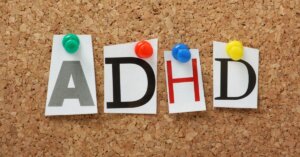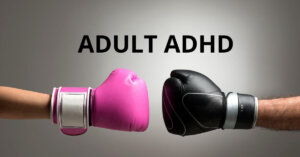Every October, there’s a renewed focus on ADHD (Attention-deficit/Hyperactivity Disorder.) The website adhdawareness month.org throws light on what progress has been made in past years, with the campaign’s theme “Moving forward with ADHD” and has a few fascinating points to make which reinforce some of the topics we have covered. ADDitude.com, the most popular internet resource on ADHD, also has its own focus in October, providing a resource center featuring leading experts, new research, and a better understanding of adult ADHD and ADHD in women and girls.
There’s too much being contributed by the organizations playing a part in this month’s ADHD awareness program for us to give a comprehensive overview of what’s moving forward with ADHD. Still, two particular points stand out that we think can be both interesting for people who have read some of our previous articles on ADHD and helpful because they give some new insights thanks to how researchers have been moving forward with ADHD studies and introducing new therapies.
month.org throws light on what progress has been made in past years, with the campaign’s theme “Moving forward with ADHD” and has a few fascinating points to make which reinforce some of the topics we have covered. ADDitude.com, the most popular internet resource on ADHD, also has its own focus in October, providing a resource center featuring leading experts, new research, and a better understanding of adult ADHD and ADHD in women and girls.
There’s too much being contributed by the organizations playing a part in this month’s ADHD awareness program for us to give a comprehensive overview of what’s moving forward with ADHD. Still, two particular points stand out that we think can be both interesting for people who have read some of our previous articles on ADHD and helpful because they give some new insights thanks to how researchers have been moving forward with ADHD studies and introducing new therapies.
Adult ADHD Occurs More Frequently in Women than Men
For many years, surveys of ADHD in population groups worldwide came up with very similar but inexplicable patterns. As we said in one of our earliest blogs marking ADHD Awareness Month, ADHD was diagnosed three to four times more frequently in boys than girls. Now, one of the most interesting articles published by the movement behind this awareness push is diving into the matter and giving fresh insight into “Understanding Girls and Women with ADHD.”
We can only give a brief precis of this comprehensive interview with one of the leading experts in the field of ADHD, Dr. Ellen B. Littman, a graduate of Brown and Yale Universities, Long Island University, and the Albert Einstein College of Medicine. She’s a clinical psychologist specializing for over 30 years in the high-IQ adolescent and adult population. The American Psychological Association has described Dr. Littman as “a pioneer in the identification of gender differences in ADHD,” and she is the author of the book on the subject “Understanding Girls with ADHD,” first published in 1999, with a second edition published in 2015.
Here are a few essential points she raises:
 month.org throws light on what progress has been made in past years, with the campaign’s theme “Moving forward with ADHD” and has a few fascinating points to make which reinforce some of the topics we have covered. ADDitude.com, the most popular internet resource on ADHD, also has its own focus in October, providing a resource center featuring leading experts, new research, and a better understanding of adult ADHD and ADHD in women and girls.
There’s too much being contributed by the organizations playing a part in this month’s ADHD awareness program for us to give a comprehensive overview of what’s moving forward with ADHD. Still, two particular points stand out that we think can be both interesting for people who have read some of our previous articles on ADHD and helpful because they give some new insights thanks to how researchers have been moving forward with ADHD studies and introducing new therapies.
month.org throws light on what progress has been made in past years, with the campaign’s theme “Moving forward with ADHD” and has a few fascinating points to make which reinforce some of the topics we have covered. ADDitude.com, the most popular internet resource on ADHD, also has its own focus in October, providing a resource center featuring leading experts, new research, and a better understanding of adult ADHD and ADHD in women and girls.
There’s too much being contributed by the organizations playing a part in this month’s ADHD awareness program for us to give a comprehensive overview of what’s moving forward with ADHD. Still, two particular points stand out that we think can be both interesting for people who have read some of our previous articles on ADHD and helpful because they give some new insights thanks to how researchers have been moving forward with ADHD studies and introducing new therapies.
ADHD in Adults is Real and Unique
The first point fills in some of the gaps and misunderstandings that have been quite common relating to Adult ADHD. I found this especially helpful because I am old enough to have grown up in a milieu where boys were “being naughty and misbehaving” when what they were really doing was manifesting typical symptoms of hyperactive behavior. It was only when I was well into my adult years that the whole concept of Adult ADHD gained a degree of respectability both in the medical community and amongst the general public. But even then, the accepted ‘fact’ was that ADHD had to manifest in early childhood and that, in a limited number of cases, it could (not would) continue to affect the person into adulthood. There’s a comprehensive history on the ADDitute website of how proponents of adult ADHD had to fight over the past few decades for recognition of the disorder if you want to get further insight into what’s moving forward with ADHD. Now, there is more evidence that ADHD can develop as a person matures, regardless of whether or not the symptoms showed up in earlier years. It’s important to emphasize that it’s not a question of saying that the disorder was there but not diagnosed (that’s a separate issue), but rather that people who grew up perfectly normally can start to show symptoms of ADHD as they mature into adulthood. When you think about it, this idea makes sense. It’s now widely accepted that ADHD has several possible causes, most of which relate not to the development of a person’s personality through childhood but to the physical environment in which their brains function. This confronts directly the old idea that’s now been rejected that ADHD is purely a personality disorder. Now, it’s taken as a fact that the existence of ADHD can be directly related to subtle changes in the balance of neurotransmitters like dopamine, serotonin, and norepinephrine. Most of the therapies that are applied involve some intervention in dopamine and other neurotransmitter levels, either through medication such as stimulants, which work on dopamine levels directly (but bring with them several unwanted side effects), or on dietary changes that correct imbalances in the components that the brain needs to produce its own supply of dopamine, such as omega-3 fatty acids (eicosapentaenoic acid & docosahexaenoic acid), L-tyrosine and phosphatidylserine.Adult ADHD Occurs More Frequently in Women than Men 
For many years, surveys of ADHD in population groups worldwide came up with very similar but inexplicable patterns. As we said in one of our earliest blogs marking ADHD Awareness Month, ADHD was diagnosed three to four times more frequently in boys than girls. Now, one of the most interesting articles published by the movement behind this awareness push is diving into the matter and giving fresh insight into “Understanding Girls and Women with ADHD.”
We can only give a brief precis of this comprehensive interview with one of the leading experts in the field of ADHD, Dr. Ellen B. Littman, a graduate of Brown and Yale Universities, Long Island University, and the Albert Einstein College of Medicine. She’s a clinical psychologist specializing for over 30 years in the high-IQ adolescent and adult population. The American Psychological Association has described Dr. Littman as “a pioneer in the identification of gender differences in ADHD,” and she is the author of the book on the subject “Understanding Girls with ADHD,” first published in 1999, with a second edition published in 2015.
Here are a few essential points she raises:
- Early on in the history of diagnosis and treatment of ADHD, parents were struggling to manage predominantly young, hyperactive, impulsive white boys. Unmanageable girls in those days would have been a source of shame, and they were not taken for diagnosis.
- Identifying girls with ADHD was based on highlighting the ones who behaved the same way as hyperactive boys since these are the only symptoms being diagnosed. However, some unique factors make most girls’ experiences with ADHD completely different from most boys. This can be attributed to estrogen’s role in girls’ lives. As they approach puberty, you see more and more ADHD symptoms. But up until a few years ago, the diagnosis had a cut-off age of just seven. If a child didn’t show symptoms by age seven, it wouldn’t be diagnosed with ADHD.
- Girls are about two percent of the focus of ADHD research, even though they’re fifty percent of the population! Furthermore, for many people, ADHD still means hyperactivity or learning problems, which is not necessarily what an inattentive girl might look like. There is a general likelihood that girls are more likely to have the inattentive presentation of ADHD, which was not even considered a possibility until 1980.
- Societal expectations are so different for girls compared to boys. At a very early age, society demands that girls accommodate others, be passively compliant, cooperate, and be neat and organized. Most girls feel compelled to strive for these ideals, even though in their ADHD brain, these executive functions perform so unreliably. As a result, they feel terrible about themselves if they can’t conform to those expectations.
- One result identified in the research is that the negative self-image in girls with ADHD can have serious outcomes. The degree to which they engage in self-harm and suicide attempts is far greater for girls with ADHD than for both boys with ADHD and all others without ADHD – self-harm is five times as likely in girls who do have ADHD than those in all other population groups. Suicide attempts are four times higher for girls with ADHD than for other girls.
- Adolescence presents far more challenges to girls than boys, which increases the risk of self-injury, eating disorders, and suicidal tendencies. A lot of physiological changes are happening inside a girl’s body that are impossible to ignore, and she has to contend with them before she can even begin to process information from the external environment.
- Research shows that peers better tolerate any ADHD symptoms shown by boys than by girls. Girls are hard on other girls who don’t conform to accepted societal roles. This can manifest in “tactile defensiveness,” in which girls with ADHD do not want to be touched because the feeling is too sensitive.
- Of particular interest to Dr. Littman has been high-IQ, inattentive girls because these are the ones who are least likely ever to be identified as having ADHD. They can be three years ahead of their peers in intellectual functioning but exhibit a three-year lag in social/emotional functioning. Someone who is intellectually three years ahead and socially/emotionally three years behind is exhibiting a six-year discrepancy between their functioning levels and that of their contemporaries. “What they do is they learn to compensate really well, but compensating masks the symptoms of ADHD.”

















